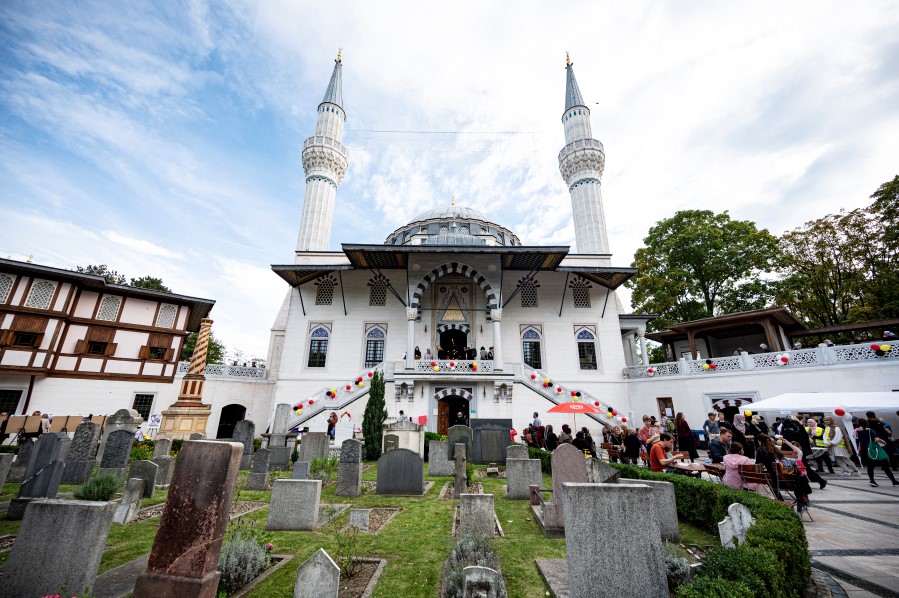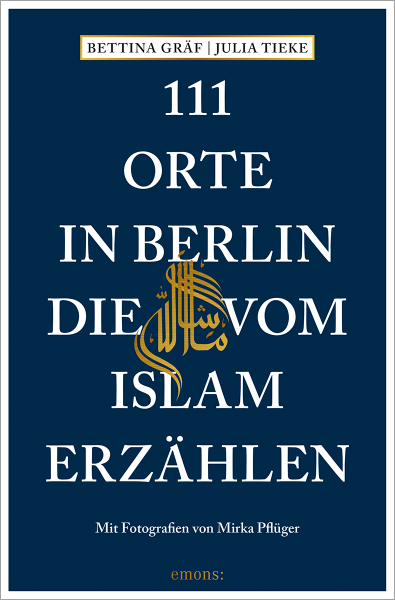Searching for traces of Muslim life in Berlin

Is Islam part of Germany? When German President Christian Wulff declared this to be the case in 2010, it triggered a heated debate that continues to this day. “Yes!” is the resounding answer from the two authors and scholars of Islam Bettina Gräf and Julia Tieke. In their new book “111 Places in Berlin That Teach Us About Islam”, they show us where and how the close links between Berlin and Islamic culture are revealed.
They lead the reader from diplomatic institutions like the Federal Foreign Office to places like Bilkiss, a Togolese tailor's in Wedding, full of brightly coloured fabrics. They visit the state library in Tiergarten, home to one of the world’s largest collections of manuscripts from Muslim societies in Asia and Africa, and the Hatun-Sürücü Bridge on Sonnenallee, named after a victim of femicide.
The authors show that there are close links between the German capital and Muslim life everywhere. These links can be found in politics, diplomacy, fantasies of “the Orient”, artistic dialogues and everyday life. Sometimes these links are revealed through huge stories, sometimes through small details.

Prussian-Ottoman partnership
That relations between Berlin and Islam are far older than the debate triggered by Wulff, is revealed by, for example, the Şehitlik Cemetery in Kreuzberg. Relations are also older than the recruitment agreement that brought the first so-called “guest workers” from Turkey to Germany in 1961.
The Ottoman Empire had a permanent diplomatic mission in Berlin as early as 1763. When the Ottoman ambassador Ali Aziz Efendi died in 1798, he was the first person to be buried in Germany according to the Islamic rites. The grave was later moved to a piece of land given to the Ottoman Sultan by William I. This is today's Şehitlik cemetery, attached to a mosque of the same name. In return, the Ottoman Sultan gave the German Emperor a plot of land in Jerusalem, on which the Protestant Monastery of Saint Saviour has been located since the 1890s.
A manhole cover in Treptow from the late 19th century provides a symbol of the imagined “Orient” for Berliners. It dates back to the Cairo exhibition in Treptower Park, which condensed thousands of years of Egyptian history and transported its visitors into a “One Thousand and One Nights” fantasy with bazaars, cafes, mosques—and an “ethnological show”.
Today, projects like the “Selam Opera!” at the Komische Oper are reminiscent of the sometimes dramatically staged “Turkish opera” of the 18th century, which depicted stories of the Ottoman sultans to the stage in an “alla-turca” musical style.
Interfaith dialogue in Berlin
Berlin has a long tradition of intercultural and interreligious life, as can be found in the chapter on the first Ahmadiyya mosque, founded in 1924. The mosque was home to the German Muslim Society, which formed before the Second World War.
In addition to aristocratic Indian migrants, the mosque attracted Prussian intellectuals and military officers, as well as Jewish intellectuals and converts. They all rejected Germany’s growing militarism and found a spiritual home in Islam.
The case of the Genezareth Church in Neukölln demonstrates that the city remains open to spiritual experimentation to this day. The church offers interfaith worship and functions as a meeting place, even for those who do not wish to be bound by a single religion.
Gräf and Tieke shed light on both prominent and hidden places, tracing lines of tradition and interconnection. Meanwhile, the history of Berlin’s Islamic sites continues to be written. For example, through a commemorative plaque created in September 2024 at the site of the so-called “Turkish Bazaar” at Bülowstraße station, which until 1993 was a meeting place for Turkish migrants with restaurants, tearooms, jewellers and record shops.
The book keeps its distance
In some places, the book can come across as somewhat clean and distanced. In particular, Mirka Pflüger’s photos can sometimes fail to fully convey the atmosphere and significance of the buildings they capture. Many of the protagonists and interviewees featured in the text are not photographed at all.
It would be nice, for example, to see the boxer Zeina Nasser, German featherweight champion, in front of her sports club Boxgirls. Nasser campaigned in Germany and internationally for the right of women to fight in headscarves and long-sleeved clothing. It would also be nice to see Jamil from Afghanistan, who has lived in Germany since 2022, in the Afghan Hall at Lichtenberg’s wholesale market.
There are also conspicuous gaps in the narrative. In the chapter on the Breitscheidplatz attack of 2016, for example, readers learn nothing about the vigils organised jointly by Muslim, Jewish and Christian Berliners.
The authors do successfully demonstrate how deeply rooted and multifaceted Muslim life in Berlin is. With historical references and religious and cultural categorisations, they invite you to search for other threads and places of encounter in the city.
And there are many more: the Alevi graveyard within St. Jacob’s Cemetery on Hermannstrasse; the Aufbruch association in Neukölln, whose founder Kazım Erdoğan was awarded the German Order of Merit for social projects in the field of violence prevention among men; the bleak “refugee-row” in Tierpark.
111 Orte in Berlin, die vom Islam erzählen
With photos by Mirka Pflueger
Emonis Literatur Verlag, 240 pages, 18 Euro (paperback)
© Qantara.de
